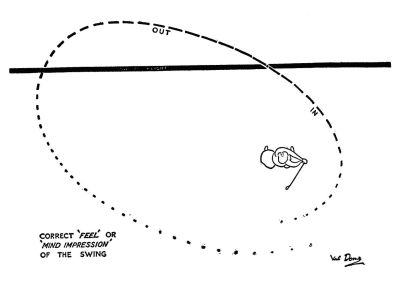This is the last part of How to Swing from In to Out.
Unless you have corrected your natural misconceptions of the golf movement by experience, you will have another feeling at the top of the swing.
You will feel that the best you can do from such a position will be to drag the ball along the ground a matter of fifty yards or so!
And because you have this powerless feeling, you try to help the club head down with arms and hands-this is "hitting from the top," one of the cardinal sins of golf.
The reason why you have this feeling of insufficiency (until experience has corrected it) is that the wide sweeping swing which comes in from behind the ball and drags it forward gives you no sensation of speed, and speed you feel you must have!
The secret of this lies in the fact that speed of swing and speed of club head are entirely different, and oddly enough it is the slow swing which, by enabling the wrists to open at the correct instant, gives you maximum club head speed where you want it - beyond the ball.
The difficulty of accepting this is that it is opposed to the natural instincts raised by our desire to hit a long way.
We feel we want club head speed so we must swing fast, not realizing that the maximum speed can only come when the momentum of the club head is free from our interference, when our opening wrists give it the speed and power of the fail.
That is why I tell you that there is no such thing as a good natural golf swing. The natural swinger is the golf rabbit!
This sort of contradiction in the interests of efficiency is not exclusive to golf.

Consider swimming. Doubtless the original "crawl" stroke was natural; its development is unnatural as anyone who watches it taught can see.
Please do not think that I have forgotten that the subject of the chapter is the in-to-out feeling.
That feeling is a somewhat subtle one, and it can only be induced by getting certain details of the swing right. So I must dwell upon these details.
The direction of swing was the first and now the source of power is the second.
I have told you not to use your arms to hit with, that in fact you should not play golf with your hands and arms at all but with your feet and legs.
Now this is an exaggeration but one that is necessary to correct the natural tendency to use our hands and arms to the detriment of foot and leg work.
The arms want to work and will work, so it is necessary to emphasize the importance of foot and leg action in order to get proper balance.
Also it is true that movement should start in the feet and legs.
Of course the arms and hands play an essential part in transmitting this power to the ball.
So, if we are told that we "are hitting with the right hand" and are advised to correct this by holding less tightly with our right hand, we merely dimmish our chance of hitting a long ball.
The long ball feels to come out of the right hand, but the power that gives it comes from the feet, the legs, and the hips.
So it is obvious that the proper use of the legs and hips is essential if we are to pull the club head in correctly-at terrific speed into the back of the ball.
Since action and reaction must be equal and opposite, we must pull against something, against some resistance. So at the top of the swing we must feel braced and very firmly set on the ground.
In a tug-of-war we can only use our weight and strength if we are well anchored. Also when we watch a boat race we are apt to think that it is the arms that are propelling the boat when actually it is the legs.
But in both these cases the movement is simple, because force is applied directly along the line of flight.
Much of the difficulty of golf arises because the source of power (our body) is not in the line of flight but is away to one side of it-so we have to produce our power and use our weight by rotation.
We are a coiled spring, wound up by our rotation, and the heavier and more powerful the spring, the greater the force that will be implanted into the back of the ball when we "unwind" onto it.
Also the greater the resistance that requires to be set up to give the spring secure anchorage. That is why it is that the farther you drive, the more important "brace" becomes.
Brace is important here for another reason also.
You will remember that it is brace in general-and the several directions of brace in particular-that hold you in such a position and condition that you feel you are "inwards and behind the back of the ball."
From this position, and swinging not up and down but around and along, you will find that the swing that feels to be taking the club head from in-to-out becomes not only possible but natural.
So you see that we have achieved this essential feel not by trying to force your club head in the direction you know you should feel it go, but by adapting a set and a conception of the correct direction of the golf movement that produces it as the natural, the almost inevitable result.



